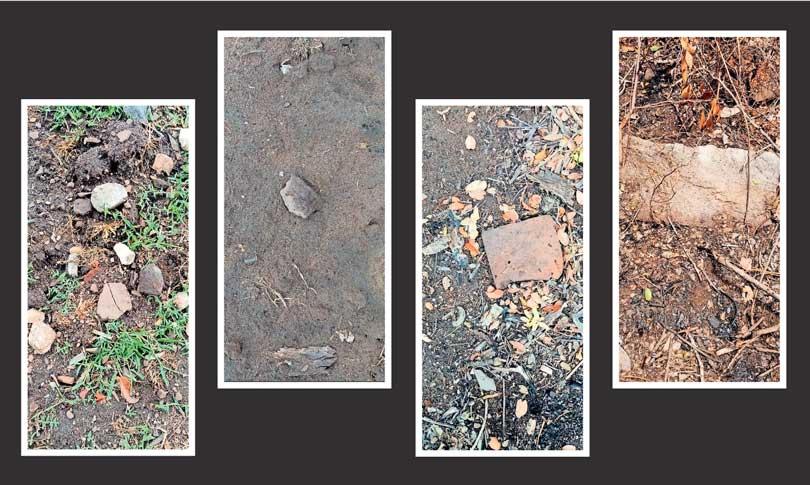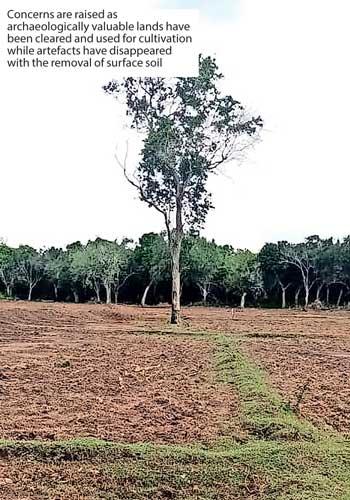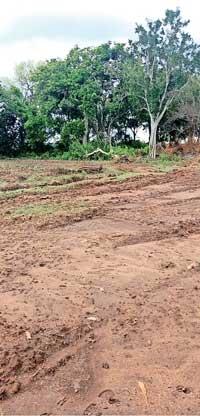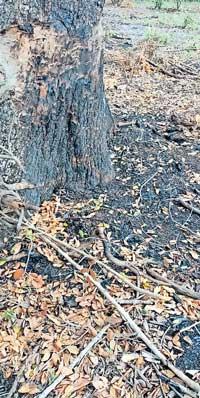Reply To:
Name - Reply Comment


Many archaeological sites in the Trincomalee district—some dating back 3000-5000 years—are on the brink of destruction at present. Ironically, this destruction increased after the war concluded in 2009. The Department of Archaeology has discovered many historical sites in the Pulmude area. Residents informed archaeological officers that land grabbing in the area was prevented during the war due to the presence of military camps.
 In a landmark case, archaeology officers, who excavated the Padmaraja Pabbata area, found that four acres of archaeological sites had been destroyed. The area was excavated after Ven. Arisimale Senasanadhipati Panamure Ariyawansa lodged a complaint with the Kuchchaveli Police. Following the discovery, archaeology officers demarcated the site with boundary poles. This was witnessed by the Trincomalee District Secretary, Divisional Secretary and Land officers. But the occupiers of those lands later took legal action against the Department of Archaeology claiming that they possessed freehold deeds, and the department has been blocked from entering the area.
In a landmark case, archaeology officers, who excavated the Padmaraja Pabbata area, found that four acres of archaeological sites had been destroyed. The area was excavated after Ven. Arisimale Senasanadhipati Panamure Ariyawansa lodged a complaint with the Kuchchaveli Police. Following the discovery, archaeology officers demarcated the site with boundary poles. This was witnessed by the Trincomalee District Secretary, Divisional Secretary and Land officers. But the occupiers of those lands later took legal action against the Department of Archaeology claiming that they possessed freehold deeds, and the department has been blocked from entering the area.
Reports indicate that the destruction of archaeological sites span the Trincomalee district. There is a danger that ancient stone pillars would be levelled and used to build houses and places of religious worship. Some stone pillars have reportedly been used as foundations for houses and as concrete. There are charges of inscriptions being thrown into rivers and some being buried. Archaeologically valuable lands have been cleared and used for cultivation. Moreover, historically artefacts have disappeared with the removal of surface soil.
The problem has been aggravated by many people having fraudulently prepared freehold deeds and other evidence to claim ownership of land. When lands are not used for cultivation, occupiers tend to build small huts and obtain connection for electricity. After verifying their residence from Grama Niladharis, they would register their names in the list of voters
The problem has been aggravated by many people having fraudulently prepared freehold deeds and other evidence to claim ownership of land. When lands are not used for cultivation, occupiers tend to build small huts and obtain connection for electricity. After verifying their residence from Grama Niladharis, they would register their names in the list of voters.
 The Central Government is also indirectly responsible for this land seizure as they hesitate to take action against perpetrators in order to gain decisive votes. Land encroachment has been well planned and going on for a considerable time. Most seizures and encroachments happen on public holidays when Government officers are absent. In most cases, no legal action is taken against perpetrators. Another problem is that police officers are unaware of archaeology-related laws, and therefore delayed taking legal action, archaeology officers revealed.
The Central Government is also indirectly responsible for this land seizure as they hesitate to take action against perpetrators in order to gain decisive votes. Land encroachment has been well planned and going on for a considerable time. Most seizures and encroachments happen on public holidays when Government officers are absent. In most cases, no legal action is taken against perpetrators. Another problem is that police officers are unaware of archaeology-related laws, and therefore delayed taking legal action, archaeology officers revealed.
In Trincomalee district particularly, it is clear that laws related to forests, wildlife and archaeology are not followed. An Extraordinary Gazette in 2000 stipulated that if 2cm of surface soil is removed for any development project, a report must be obtained from the Department of Archaeology verifying the absence of any damage to archaeological sites.
But this law appears nonexistent in Trincomalee. Unlike in Polonnaruwa or Anuradhapura, archaeological sites in the Trincomalee district are not closely located. When officers hear of destruction they lack vehicles to visit such places. In Polonnaruwa and Anuradhapura residents must inform archaeology officers even before digging a toilet pit. But in Trincomalee such information rarely reaches officers.
In Trincomalee district particularly, it is clear that laws related to forests, wildlife and archaeology are not followed. An Extraordinary Gazette in 2000 stipulated that if 2cm of surface soil is removed for any development project, a report must be obtained from the Department of Archaeology verifying the absence of any damage to archaeological sites
Another issue is language. Many archaeological officers employed in Trincomalee district do not speak Tamil, and there is a need to deploy more Tamil-speaking officers to the area. On occasions when residents attempt to complain to officers, the language barrier hampers them. Many residents cannot speak Sinhala and officers and residents find it hard to communicate in English as well.
Archaeology officers also lack proper accommodation. Many of them are not area residents and come from places like Colombo, Kegalle, Kuliyapitiya and Kurunegala. “We cannot save money from our Rs 20000-30000 salary as we must spend it on transport,” the officers complained. The Department also delays paying them transportation costs, and they could not buy essential items needed for their duties, the officers further charged. Wild elephants roam the roads the officers frequently go from Trincomalee to Mora Wewa, Yan Oya, Kinniya and Sampoor. So their lives are at risk during duty. “Therefore we cannot fulfill our duties to our best,” they noted. Another reason for the destruction of archaeology lands is the employment of officers with archaeology knowledge to administrative positions. Promotions are also delayed, officers charged.
Although the Department of Archaeology has a history of 120-130 years, it has not conducted formal excavations in the Northern and Eastern provinces. Many places under the Archaeology Department in these provinces are merely marked with boards. Even though it was impossible to protect these places during war, the authorities should implement a proper plan at least now.
Skilled researchers have discovered stone tools from pre-historic human settlements during excavations in the area. These sites are not closely located and are often randomly discovered. But the findings are priceless. The danger is that removal of surface soil can destroy evidence of a history spanning over 5000 years.
Permits for granite quarries
People have also destroyed marshlands in the area by clearing and cultivating them. This has endangered animals endemic to these habitats. Continuous granite mining has also destroyed ancient stone inscriptions. Permits for granite quarries have been given out without preliminary studies being conducted. By the time these areas are discovered to be archaeologically valuable, they would have been destroyed.
For example, in efforts to identify the Padmaraja Pabbata archaeological boundaries in the Kuchchaveli area, archaeology officers found out that many valuable artifacts had already been destroyed. There is historical evidence to prove that there had been a geographical zone in the area some 1000-1100 years ago. The zone had consisted of brown earth wide plains, granitoid rocks and gneiss rocks. The civilization is believed to have flourished alongside the Yan Oya, Sannagam Kattu Kulama, Atha Bendi Wewa and Pani Ketiyawa Wewa.
Often, old tombs serve as the best examples for archaeological evidence. For example, stone inscriptions, ancient stone pillars, moon stones and stone tools found in the area highlight the archaeological value of Padmaraja Pabbatha. Moreover, evidence of human settlements during the Iron Age have been found in the valleys of the Pahala Yan Oya.
When officers hear of destruction they lack vehicles to visit such places. In Polonnaruwa and Anuradhapura residents must inform archaeology officers even before digging a toilet pit. But in Trincomalee such information rarely reaches officers
 Overall, archaeologically valuable sites in the Trincomalee district include the Girihadu Stupa, Pichcha Mal Viharaya, Asiri Kanda Purana Rajamaha Viharaya, Sembukuliya, Atha Nagina Kanda, Mihindu cave, Naga cave, Naga Pabbatha, Neelapanikam, Babaragala, Dewaragala, Padma Raja Pabbatha, Sathya Gaveshi Pabbatha and Aada Wewa are several. Moreover, Kallarawa located in the Yan Oya estuary is considered an old shipping hub.
Overall, archaeologically valuable sites in the Trincomalee district include the Girihadu Stupa, Pichcha Mal Viharaya, Asiri Kanda Purana Rajamaha Viharaya, Sembukuliya, Atha Nagina Kanda, Mihindu cave, Naga cave, Naga Pabbatha, Neelapanikam, Babaragala, Dewaragala, Padma Raja Pabbatha, Sathya Gaveshi Pabbatha and Aada Wewa are several. Moreover, Kallarawa located in the Yan Oya estuary is considered an old shipping hub.
Unfortunately, different groups have destroyed many of these places and established illegal settlements. Inquiries should be made to find out if archaeological officers cannot enforce laws due to Central Government policies.
Trincomalee district Acting Assistant Director of the Archaeology Department, Y. W. U. M. Ananda said boundaries had been marked in the district to protect historical sites. “A group living near the Padmaraja Pabbata area has filed a court case against the boundary marking. I cannot divulge more details as there is an ongoing case. We marked the boundaries to prevent the destruction of archaeological places,” he said.
Ananda added many such areas in Trincomalee had been marked with boundaries and were being protected by the Archaeology Department. “For now the Padmaraja Pabbata boundaries are temporarily marked until we get the court verdict. We will implement a programme with the help of the Army, forest, wildlife and archaeology officers to safeguard archaeological places in Trincomalee,” he said.
Commenting on problems faced by archaeology officers, Additional Director General (Admin) of the Archaeology Department P. A. S. H. Boralessa said that the Accounting Section paid the bills of those who engaged in field trips. “Archaeology officers who work in Trincomalee stay in places they have found themselves,” she said.
Meanwhile Archaeology Director General Prof. Senarath Dissanayake said that there is already a programme in the Eastern province implemented through the Presidential Task Force to safeguard archaeological sites, and officers were studying those areas and demarcating boundaries. “There is archaeological destruction in the Eastern province, and we have taken immediate steps to preserve these places. In three months we will start setting boundaries to mark archaeological places in the Batticaloa district, and we will begin boundary marking in Trincomalee after that,” he said.